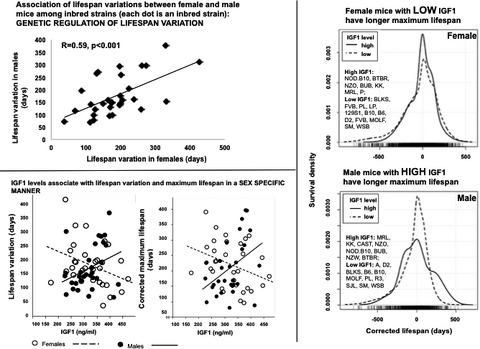当前位置:
X-MOL 学术
›
Aging Cell
›
论文详情
Our official English website, www.x-mol.net, welcomes your feedback! (Note: you will need to create a separate account there.)
Genetic differences and longevity‐related phenotypes influence lifespan and lifespan variation in a sex‐specific manner in mice
Aging Cell ( IF 7.8 ) Pub Date : 2020-10-26 , DOI: 10.1111/acel.13263 Rong Yuan 1 , C J M Musters 2 , Yun Zhu 1, 3 , Tracy R Evans 4 , Yujie Sun 1, 5 , Elissa J Chesler 6 , Luanne L Peters 6 , David E Harrison 6 , Andrzej Bartke 1
Aging Cell ( IF 7.8 ) Pub Date : 2020-10-26 , DOI: 10.1111/acel.13263 Rong Yuan 1 , C J M Musters 2 , Yun Zhu 1, 3 , Tracy R Evans 4 , Yujie Sun 1, 5 , Elissa J Chesler 6 , Luanne L Peters 6 , David E Harrison 6 , Andrzej Bartke 1
Affiliation

|
Epidemiological studies of human longevity found two interesting features, robust advantage of female lifespan and consistent reduction of lifespan variation. To help understand the genetic aspects of these phenomena, the current study examined sex differences and variation of longevity using previously published mouse data sets including data on lifespan, age of puberty, and circulating insulin‐like growth factor 1 (IGF1) levels in 31 inbred strains, data from colonies of nuclear‐receptor‐interacting protein 1 (Nrip1) knockout mice, and a congenic strain, B6.C3H‐Igf1. Looking at the overall data for all inbred strains, the results show no significant difference in lifespan and lifespan variation between sexes; however, considerable differences were found among and within strains. Across strains, lifespan variations of female and male mice are significantly correlated. Strikingly, between sexes, IGF1 levels correlate with the lifespan variation and maximum lifespan in different directions. Female mice with low IGF1 levels have higher variation and extended maximum lifespan. The opposite is detected in males. Compared to domesticated inbred strains, wild‐derived inbred strains have elevated lifespan variation due to increased early deaths in both sexes and extended maximum lifespan in female mice. Intriguingly, the sex differences in survival curves of inbred strains negatively associated with age of female puberty, which is significantly accelerated in domesticated inbred strains compared to wild‐derived strains. In conclusion, this study suggests that genetic factors are involved in the regulation of sexual disparities in lifespan and lifespan variation, and dissecting the mouse genome may provide novel insight into the underlying genetic mechanisms.
中文翻译:

遗传差异和长寿相关表型以性别特异性方式影响小鼠的寿命和寿命变异
人类寿命的流行病学研究发现了两个有趣的特征,女性寿命的强大优势和寿命变异的持续减少。为了帮助理解这些现象的遗传方面,当前的研究使用以前发表的小鼠数据集检查了性别差异和寿命的变化,包括寿命、青春期年龄和 31 个近交系中循环胰岛素样生长因子 1 (IGF1) 水平的数据。菌株,来自核受体相互作用蛋白 1 ( Nrip1)菌落的数据) 基因敲除小鼠和同类品系 B6.C3H-Igf1。查看所有近交品系的总体数据,结果显示两性之间的寿命和寿命差异没有显着差异;然而,在菌株之间和菌株内部发现了相当大的差异。在不同品系中,雌性和雄性小鼠的寿命差异显着相关。引人注目的是,在两性之间,IGF1 水平与不同方向的寿命变化和最大寿命相关。IGF1 水平低的雌性小鼠具有更高的变异性并延长了最大寿命。在男性中检测到相反的情况。与驯化的近交品系相比,野生来源的近交品系由于两性早期死亡的增加和雌性小鼠的最大寿命延长而具有更高的寿命变异。耐人寻味的是,自交品系存活曲线的性别差异与女性青春期年龄呈负相关,与野生来源品系相比,驯化自交品系显着加速。总之,这项研究表明遗传因素参与了寿命和寿命变异中性别差异的调节,解剖小鼠基因组可能会提供对潜在遗传机制的新见解。
更新日期:2020-11-23
中文翻译:

遗传差异和长寿相关表型以性别特异性方式影响小鼠的寿命和寿命变异
人类寿命的流行病学研究发现了两个有趣的特征,女性寿命的强大优势和寿命变异的持续减少。为了帮助理解这些现象的遗传方面,当前的研究使用以前发表的小鼠数据集检查了性别差异和寿命的变化,包括寿命、青春期年龄和 31 个近交系中循环胰岛素样生长因子 1 (IGF1) 水平的数据。菌株,来自核受体相互作用蛋白 1 ( Nrip1)菌落的数据) 基因敲除小鼠和同类品系 B6.C3H-Igf1。查看所有近交品系的总体数据,结果显示两性之间的寿命和寿命差异没有显着差异;然而,在菌株之间和菌株内部发现了相当大的差异。在不同品系中,雌性和雄性小鼠的寿命差异显着相关。引人注目的是,在两性之间,IGF1 水平与不同方向的寿命变化和最大寿命相关。IGF1 水平低的雌性小鼠具有更高的变异性并延长了最大寿命。在男性中检测到相反的情况。与驯化的近交品系相比,野生来源的近交品系由于两性早期死亡的增加和雌性小鼠的最大寿命延长而具有更高的寿命变异。耐人寻味的是,自交品系存活曲线的性别差异与女性青春期年龄呈负相关,与野生来源品系相比,驯化自交品系显着加速。总之,这项研究表明遗传因素参与了寿命和寿命变异中性别差异的调节,解剖小鼠基因组可能会提供对潜在遗传机制的新见解。


























 京公网安备 11010802027423号
京公网安备 11010802027423号